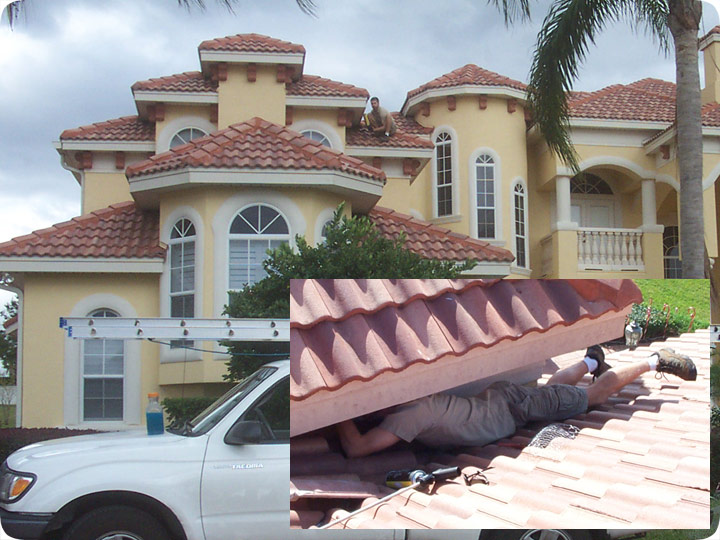-
info@aaanimalcontrol.com
Call us for help in your town
Humane Wildlife Education
Fix Holes in Roof to Keep Out Animals

12.21.2005 - This house was located in a very fancy neighborhood in Orlando, right behind a gleaming white Mormon temple and surrounded by other beautiful houses. But
the inside of this house was not so beautiful and gleaming. It was filled with rats and squirrels, and all the droppings, urine, nesting material, parasites, and odor that come
with a rodent infestation.
I was called in to take care of the situation. The homeowner heard a lot of scratching and running and scampering around, both day and
night. When I arrived at the home, I took one glance at it, and I knew the problem - the dreaded barrel tile roof. Barrel tile roofs allow the easiest ways for
animals to get into attics. While these tiles may look pretty, they leave thousands of gaps that critters can use to get into the attic.
Any given house has
various holes and entry points in the roof. These areas can be vents, pluming stacks, and more. If a rat or squirrel gets under the tiles - and there's a ready-made
opening under every one at the perimeter, they just crawl along and can enter the hole. But more commonly than that, there's the area where the eaves abut against the
roof. On many homes, the flat eave is flush with the flat roof. But with barrel tile, you've got a series of wide gaps that lead right into the attic, and rats and
squirrels don't hesitate to move right in. This was a brand-new house!
In order to solve the problem, I spend a LONG time sealing off all the openings that the
barrel tile left in the roof. You can see me in these photos addressing those eave gap areas. Sometimes I have to crawl in dangerous areas of the roof where ladders
cannot go, such as in the large photo, and sometimes I have to squirm into tight areas in order to reach every spot, such as in the insert photo.
Do it yourself: Visit my How To Get Animals Out of the Attic page for tips and advice.
Get professional help: Visit my Nationwide Pro Directory of wildlife removal experts.
Remember, the most important step in a total wildlife control solution is to stop the source of the problem - if you have wild critters in your attic or home, the only way to permanently solve the problem is to close all the entry points! This is a special
skill, and it requires extensive knowledge of both architecture and animal behavior. Being a skilled repairman also helps. All repairs should be done in such a way that keeps animals out for good - this often means sealing with steel, and sealing openings
so that they are airtight, with no trace of airflow for animals to detect. Remember, rodents can gnaw through almost anything, and raccoons can tear through almost anything. While it's important to trap and remove animals, and clean up the waste they leave
behind, the most important step in solving the critter problem and in keeping animals out forever is to identify and repair every last critter access point into the building. Without this crucial step, the job isn't complete.
For more wildlife stories, click my Wildlife Blog
or click my below banner to hire a local trapper.
Do you have critters living in your attic? It's very frustrating, right? Well, you're not alone, many homeowners also share your plight. Since most of the common critters that get into attics are small, their entry holes are usually relatively small. Even though the most common critters that enter attics are squirrels and bats, there could be cases where you find large critters such as raccoons.
So, the size of the holes and gaps between your wall and roof will dictate the size of the critters you're likely to find in your attic and on the roof as well. Every house is likely to have holes and entry points on the roof. Such areas include plumbing stacks, vents, and any other place with a gap that the critters can squeeze through. If you have a barrel tile roof, the problem could be even worse as it leaves thousands of gaps that rats, squirrels, and bats can easily go through.
While some homeowners prefer barrel tiles due to their beauty, there are major caveats when it comes to keeping your house free from messy critters, which are always in search of any gap to squeeze through into the attic. Besides that, the gaps left between the flat eaves and the wall can also play a critical role in getting the critters into your attic. With various routes used by animals to get to your roof in mind, we can now get to the ways of sealing off all the animal entry points. Ready to get started? Below are the essential steps to get the work done.
- Find out if animals are living in the attic before you start sealing the holes and gaps to avoid trapping them in.
- If you find out that some critters are already in the attic, you should install excluders to allow the critters to get out without getting back in. You can also trap and relocate bigger animals such as raccoons or possums before sealing off the entry routes.
- Seal all the entry holes to keep the animals out forever. You can use caulking material for tiny holes and an appropriate sealant for relatively large gaps. For gaps that can't be sealed with a sealant, you can hire a skilled maintenance specialist to get the job done.
- Apart from sealing small holes, you should repair all the damaged parts of the roof that provides a potential entry route for large animals such as raccoons. When done with all these, you shall have blocked out all the critters from your home.




















